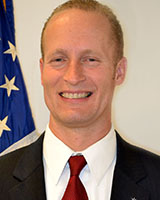

David Shive, the GSA chief information officer, said encouraging more employees to take advantage of the virtual desktop interface (VDI) technology, and modernizing...
The General Services Administration now is moving to the next level with its IT consolidation effort.
GSA first merged three separate technology offices into one with a focus on better customer service in 2012.

Three years later, David Shive, the GSA chief information officer, said he’s now focusing on the longer-term, more complex changes.
“We started the good work of rationalizing our infrastructure and our applications. That work is not complete and we have not derived all the value out of that work that we can so we will continue those activities,” he said. “We are working on modernizing some of our acquisition processes. We play a key role in some of those, like standing up the Acquisition Gateway and other tools like that, which we are exceedingly proud of. We’re updating a fair number of our governmentwide systems like USA.gov, transforming those so that those systems and the capabilities they provide are increasingly useful to the citizens and agencies that we serve.”
Shive said he’s also working with the Public Buildings Service to modernize its mission-critical applications.
“There’s a lot of talk about the Internet of Things. We are living and breathing that every single day as you look at public buildings across the federal enterprise, it’s a data-rich environment. For every elevator you ride up and down in, for every cooling system that you walk through, for every lighting system you sit under and for every door that you go through, there is data there,” he said. “We are looking at our data management strategies so we can effectively coalesce that data, and putting good predictive analytics on top of that so that we can make good decisions about things that are happening, and predicting things that are going to happen and drive down costs for things like maintenance of infrastructure.”
As the amount of data grows, Shive said GSA is relying on analytics tools to help make better decisions.
He said GSA recently launched a new platform called data-to-decisions, which includes a suite of capabilities to access different databases and take that information and apply business intelligence tools.
“We’ve created a mechanism where we can be agnostic about what tools we use and choose the best-in-breed tools as rapidly as they come out, because that is an industry that is leaping forward every six months,” he said.
Shive, who took over as CIO in April and has worked at GSA since 2012, has played a key role in the reorganization of the office in terms of the concept and implementation.
GSA reorganization stemmed from former Administrator Dan Tangherlini’s internal review of agency processes in the wake of the Western Regions Conference scandal that became public in 2011.
Shive said the fact he’s been part of the CIO’s office and part of the decision making executive team, he is carrying forward the vision of the organization.
To that end, Shive is continuing not only with the next steps of consolidation, but on several other enterprisewide initiatives, including open source and implementing virtual desktop interface (VDI).
Shive said GSA is making progress in using open source software.
“Right now, every procurement that we look at, every operational IT item that we develop and try to deliver, we look to see if there are opportunities to use open source. It’s baked into our DNA. It’s in every part of what we do,” he said. “We have repositories that are open to every GSA developer so that we can share work amongst each other. Then, we also open that up to the larger federal government. We have a tool called GSA labs where we’ve opened up the development components that we have developed in our Salesforce environment out to the rest of the federal government. Other government agencies are coming in and using and reusing those components.”



Shive said GSA also uses GitHub to promote tools and components into the larger government and private sector community.
Under the VDI initiative, GSA set a goal in 2013 of enabling at least 75 percent of all employees to use VDI by the end of fiscal 2015.
Shive said GSA beat that goal at the end of the fiscal year, and now is ready to get employees to use the technology.
“What that means is any employee who wants to engage or use VDI will absolutely be able to do so, and they will be able to do some from any device whether it’s their laptop, their tablet, heck, I can spin up a Windows machine on my cell phone if I need to,” he said. “The next step is increasing the adoption of the technology. We’ve done our classic communication campaigns. We’ve let people know the tools are there. We have enabled the infrastructure and sized so it can handle peak loads during crisis situations like snowstorms and things like that. But now the next thing is to get people to use it.”
Shive said the move to VDI also had secondary benefits, including being a system enabler and extender particularly for legacy systems, mobile devices and continuity of operations planning.
Copyright © 2025 Federal News Network. All rights reserved. This website is not intended for users located within the European Economic Area.
Jason Miller is executive editor of Federal News Network and directs news coverage on the people, policy and programs of the federal government.
Follow @jmillerWFED
